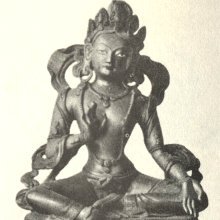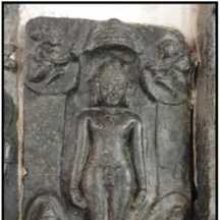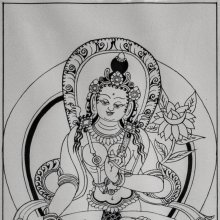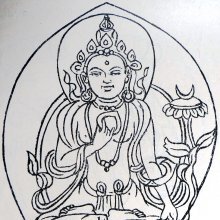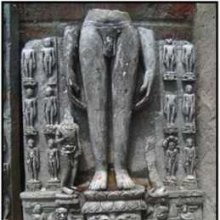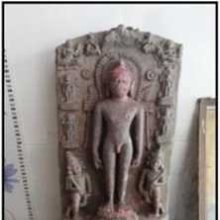Candraprabha, Candraprabhā, Candra-prabha: 29 definitions
Introduction:
Candraprabha means something in Buddhism, Pali, Hinduism, Sanskrit, Jainism, Prakrit, biology. If you want to know the exact meaning, history, etymology or English translation of this term then check out the descriptions on this page. Add your comment or reference to a book if you want to contribute to this summary article.
Alternative spellings of this word include Chandraprabha.
Images (photo gallery)
(+16 more images available)
In Hinduism
Purana and Itihasa (epic history)
Source: Wisdom Library: Varāha-purāṇaCandraprabhā (चन्द्रप्रभा) is the name of a beautiful damsel (kanyā), with black curly hair and red lips, according to the Varāhapurāṇa chapter 92. Candraprabhā (and other innumerable ladies) arose out of the agitation of Vaiṣṇavī while she was doing penance at Viśālā. For these young women, Vaiṣṇavī created the city Devīpura, containing numerous mansions with golden balconies, crystal stairs and water fountains, with jewelled windows and gardens.
Vaiṣṇavī is the form of Trikalā having a red body representing the energy of Viṣṇu. Trikalā is the name of a Goddess born from the combined looks of Brahmā, Viṣṇu and Maheśvara (Śiva).
The Varāhapurāṇa is categorised as a Mahāpurāṇa, and was originally composed of 24,000 metrical verses, possibly originating from before the 10th century. It is composed of two parts and Sūta is the main narrator.
Source: archive.org: Puranic Encyclopedia1) Candraprabha (चन्द्रप्रभ).—(See Sūryaprabhā).
2) Candraprabhā (चन्द्रप्रभा).—Mother of the wonderful girl, Somaprabhā. (See Somaprabhā).
Source: Cologne Digital Sanskrit Dictionaries: The Purana Index1a) Candraprabha (चन्द्रप्रभ).—A son of Maṇibhadra.*
- * Vāyu-purāṇa 69. 155.
1b) Mountain north-west of Kailāsa; here are lake Svacchoda, river Svacchoda, forest Caitraratham, residence of Maṇibhadra, commander-in-chief of the Yakṣas.*
- * Brahmāṇḍa-purāṇa II. 18. 5-8; Matsya-purāṇa 121. 6; Vāyu-purāṇa 47. 5.
1c) A lake on the slopes of Meru Mt.*
- * Brahmāṇḍa-purāṇa II. 18. 68; Vāyu-purāṇa 47. 65.
1d) The name of Ila's horse which became a mare in the Śaravana forest.*
- * Matsya-purāṇa 12. 3.

The Purana (पुराण, purāṇas) refers to Sanskrit literature preserving ancient India’s vast cultural history, including historical legends, religious ceremonies, various arts and sciences. The eighteen mahapuranas total over 400,000 shlokas (metrical couplets) and date to at least several centuries BCE.
Kavya (poetry)
Source: Wisdom Library: Kathāsaritsāgara1) Candraprabhā (चन्द्रप्रभा) is the wife of Dharmagupta: a richt merchant from the city Pāṭaliputra, according to the Kathāsaritsāgara, chapter 17. She gave birth to an apsaras (heavenly nymph) named Somaprabhā. Their story was told by Vasantaka to Padmāvatī and queen Vāsavadattā.
2) Candraprabha (चन्द्रप्रभ) is the name of a prince (son of king Ādityaprabha) who was accidentally slain and cooked by Sāhasika, instead of Phalabhūti, for the purpose of a magic rite, according to the Kathāsaritsāgara, chapter 20. Phalabhūti is the supposed name of Somadatta (one of the two sons of Agnidatta). Their story was told by Yaugandharāyaṇa to king Udayana in order to demonstrate that a sensible man will not injure one who treats him well, for whoever does, will find that it turns out unfortunately for himself.
3) Candraprabhā (चन्द्रप्रभा) is the name of a Vidyādharī and eldest of the four daughters of king Śaśikhaṇḍa, according to the “story of the golden city”, according to the Kathāsaritsāgara, chapter 26. Accordingly, Candraprabhā said to Śaktideva: “... there is in this land a king of the Vidyādharas named Śaśikhaṇḍa, and we four daughters were born to him in due course; I am the eldest, Candraprabhā, and the next is Chandrarekhā, and the third is Śaśirekhā, and the fourth Śaśiprabhā. We gradually grew up to womanhood in our father’s house, and once upon a time those three sisters of mine went together to the shore of the Ganges to bathe, while I was detained at home by illness; then they began to play in the water, and in the insolence of youth they sprinkled with water a hermit named Agryatapas while he was in the stream”.
4) Candraprabha (चन्द्रप्रभ), son of Aṅgāraprabha, is the name of an ancient king of Śākala, according to the Kathāsaritsāgara, chapter 44. Accordingly, as Vajraprabha said to Naravāhanadatta: “of old there was in the country of the people of Madra a town named Śākala; Candraprabha, the son of Aṅgāraprabha, was king of it. By his wife, named Kīrtimatī, there was born to that king a son, whose future glory was indicated by his exceedingly auspicious marks”.
5) Candraprabhā (चन्द्रप्रभा) is the name of a princess from Mahadha, as mentioned in the third story of the Vetālapañcaviṃśati in the Kathāsaritsāgara, chapter 77. Accordingly, “... and the prince [Vikramakeśarin] married as a wife, by the advice of the parrot, a princess of equal birth, of the royal family of Magadha, named Candraprabhā. That princess also possessed a similar hen-maina, of the name of Somikā, remarkable for knowledge and discernment”.
6) Candraprabhā (चन्द्रप्रभा) is the wife of king Yaśaḥketu from Śivapura, as mentioned in the fifteenth story of the Vetālapañcaviṃśati in the Kathāsaritsāgara, chapter 89. Accordingly, “... [king Yaśaḥketu] devolved upon his minister, named Prajñāsāgara, the burden of his kingdom, and enjoyed himself in the society of his queen, Candraprabhā. And in course of time that king had born to him, by that queen, a daughter named Śaśiprabhā, bright as the moon, the eye of the world”.
7) Candraprabha (चन्द्रप्रभ) is the name of an ancient king from Ujjayinī according to the eighteenth story of the Vetālapañcaviṃśati in the Kathāsaritsāgara, chapter 92. Accordingly, “... in that city [Ujjayinī] there was a learned Brāhman, named Devasvāmin, who had offered many sacrifices, and possessed great wealth, and who was highly honoured by the king, whose name was Candraprabha”.
8) Candraprabha (चन्द्रप्रभ) is the son of king Sūryaprabha from Vakraloka, although he was conceived by Manaḥsvāmin and Dhanavatī, according to the nineteenth story of the Vetālapañcaviṃśati in the Kathāsaritsāgara, chapter 93. Accordingly, “... and King Sūryaprabha spent twelve days in music, and dancing, and other amusements, and then he gave that son the name of Candraprabha. And gradually Prince Candraprabha increased in stature as well as in excellent character, delighting his dependents by both. And in course of time he grew up, and became capable of bearing the weight of the earth, winning over the subjects by his courage, his generosity, his learning and other accomplishments”.
The Kathāsaritsāgara (‘ocean of streams of story’), mentioning Candraprabhā, is a famous Sanskrit epic story revolving around prince Naravāhanadatta and his quest to become the emperor of the vidyādharas (celestial beings). The work is said to have been an adaptation of Guṇāḍhya’s Bṛhatkathā consisting of 100,000 verses, which in turn is part of a larger work containing 700,000 verses.

Kavya (काव्य, kavya) refers to Sanskrit poetry, a popular ancient Indian tradition of literature. There have been many Sanskrit poets over the ages, hailing from ancient India and beyond. This topic includes mahakavya, or ‘epic poetry’ and natya, or ‘dramatic poetry’.
Ayurveda (science of life)
Nighantu (Synonyms and Characteristics of Drugs and technical terms)
Source: WorldCat: Rāj nighaṇṭuCandraprabhā (चन्द्रप्रभा) is another name for Vākucī, a medicinal plant identified with Psoralea corylifolia Linn. (“Babchi”) from the Fabaceae or “legume” family of flowering plants, according to verse 4.62-65 of the 13th-century Raj Nighantu or Rājanighaṇṭu. The fourth chapter (śatāhvādi-varga) of this book enumerates eighty varieties of small plants (pṛthu-kṣupa). Together with the names Candraprabhā and Vākucī, there are a total of twenty-one Sanskrit synonyms identified for this plant.
Kalpa (Formulas, Drug prescriptions and other Medicinal preparations)
Source: Shodhganga: Edition translation and critical study of yogasarasamgrahaCandraprabhā refers to a medicinal recipe mentioned in the Guḷikākhaṇḍa (verse 7.41) of the 15th-century Yogasārasaṅgraha (Yogasara-saṅgraha) by Vāsudeva: an unpublished Keralite work representing an Ayurvedic compendium of medicinal recipes. The Guḷikākhaṇḍa [mentioning candraprabhā] contains recipes that treat patients suffering from conditions such as shivering fever, bleeding, cough, heart diseases, chlorosis, piles, pain in vagina, constipation, etc.

Āyurveda (आयुर्वेद, ayurveda) is a branch of Indian science dealing with medicine, herbalism, taxology, anatomy, surgery, alchemy and related topics. Traditional practice of Āyurveda in ancient India dates back to at least the first millenium BC. Literature is commonly written in Sanskrit using various poetic metres.
Shaivism (Shaiva philosophy)
Source: SOAS University of London: Protective Rites in the Netra TantraCandraprabha (चन्द्रप्रभ) refers to the “splendor of the moon”, according to the Netratantra of Kṣemarāja: a Śaiva text from the 9th century in which Śiva (Bhairava) teaches Pārvatī topics such as metaphysics, cosmology, and soteriology.—Accordingly, [verse 2.22cd-28ab]—“[...] That which is described is celebrated in the world as the supreme Amṛta [sa], this is the highest dwelling place. It is the highest Amṛta. Joined with the kalā nectar [visarga], filled with the splendor of the moon (pūrṇa-candraprabha-upama). It is the highest abode [of Śiva]. That is the supreme word. That is supreme strength, that is supreme amṛta. The highest of splendors is highest light of light. [...]”.

Shaiva (शैव, śaiva) or Shaivism (śaivism) represents a tradition of Hinduism worshiping Shiva as the supreme being. Closely related to Shaktism, Shaiva literature includes a range of scriptures, including Tantras, while the root of this tradition may be traced back to the ancient Vedas.
In Buddhism
Tibetan Buddhism (Vajrayana or tantric Buddhism)
Source: Wisdom Library: MañjuśrīnāmasaṃgītiCandraprabha (चन्द्रप्रभ) is one of the sixteen bodhisattvas appearing in the Vajradhātu-mahāmaṇḍala, according to the Nāmamantrārthāvalokinī v5.38-41. The Nāmamantrārthāvalokinī (literally, ‘an explanation of the nāma-mantras’) is a commentary (ṭīkā) on the 8th century Mañjuśrīnāmasaṃgīti.
Candraprabha is a name of Mañjuśrī (the embodiement of non-dual knowledge) and, together with other names, forms the core essence of the Mañjuśrīnāmasaṃgīti. The Nāmamantrārthāvalokinī provides the practitioner a sādhana (‘meditative practice’) to turn these names into mantras. These mantras are chanted for the benefit of all beings, and then placed and contemplated in the Vajradhātu-mahāmaṇḍala, which is an extended version of the Vajradhātu-maṇḍala.
Source: archive.org: The Indian Buddhist Iconography1) Candraprabha (चन्द्रप्रभ) (“light of the moon”) is the name of a Bodhisattva commonly depicted in Buddhist Iconography, and mentioned in the 11th-century Niṣpannayogāvalī of Mahāpaṇḍita Abhayākara.—his color is white; his symbol is the moon on lotus.
Candraprabha is described in the Niṣpannayogāvalī as follows:—
(1: Mañjuvajra-maṇḍala):—“Candraprabha is of white colour like the moon. He holds in his left hand the disc of the moon on a lotus, and displays the Varada-mudrā in his right”. (2: Dharmadhatūvāgīśvara-maṇḍala):—“Candraprabha is white in colour. He holds in his right hand the discus marked with a Vajra, and in the left the disc of the moon on a lotus”. (3: Durgatipariśodhana-maṇḍala):—“Candraprabha is white in colour. He holds the moon on a lotus in the tight hand while the clenched left rests on the hip”.
Candraprabha is sometimes seen accompanying Mañjuśrī, as depicted in Buddhist Iconography.—[...] Sometimes Mañjuśrī is accompanied only by Yamāri, sometimes only by his Śakti or female counterpart, sometimes by Sudhanakumāra and Yamāri and sometimes again by the four divinities, Jālinīprabha (also called Sūryaprabha), Candraprabha, Keśinī and Upakeśinī. Though the last four are required to be present with Arapacana, they are nevertheless found in others also.
2) Candraprabha (चन्द्रप्रभ) or Candraprabhalokeśvara refers to number 43 of the 108 forms of Avalokiteśvara found in the Machhandar Vahal (Kathmanu, Nepal). [Machhandar or Machandar is another name for for Matsyendra.].
Accordingly,—
“Candraprabha also is one-faced and two-armed and sits in the Vajraparyaṅka attitude on a lotus. He exhibits the Vitarka mudrā with his right hand and holds the stem of a lotus against the chest with his left”.
The names of the 108 deities [viz., Candraprabha] possbily originate from a Tantra included in the Kagyur which is named “the 108 names of Avalokiteshvara”, however it is not yet certain that this is the source for the Nepali descriptions.Source: Brill: Śaivism and the Tantric Traditions (tantric Buddhism)
Candraprabha (चन्द्रप्रभ) refers to one of the sixteen Bhadrakalpa Bodhisattvas, according to the Niṣpannayogāvalī 44ff and Abhayākaragupta’s Durgatipariśodhana-maṇḍala (Cf. Niṣpannayogāvalī 66ff.).—A set of sixteen Bodhisattvas often supplements the deities of the Tattvasaṃgraha in later Vajradhātu-maṇḍala descriptions. These are generally the sixteen Bodhisattvas of the present aeon (bhadrakalpa) [e.g., Candraprabha], as described for example in Abhayākaragupta’s Niṣpannayogāvalī Vajradhātu-maṇḍala.—Cf. also Nāmamantrārthāvalokinī and Abhayākaragupta’s forty-three deity Mañjuvajra-maṇḍala (Tricatvāriṃśadātmakamañjuvajra-maṇḍala: see Niṣpannayogāvalī 50)
Source: WikiPedia: Tibetan BuddhismCandraprabha (चन्द्रप्रभ) (in Tibetan: Dawäi Ö) (1227–1327 CE) refers to the fourteenth of the twenty-five Kalki kings (of Shambhala) who represents the holders of the Kalachakra (“wheel of time”) teachings of Buddha Shakyamuni.—The king Candraprabha is described as “lord of secret mantras, holder of the wheel and conch”.

Tibetan Buddhism includes schools such as Nyingma, Kadampa, Kagyu and Gelug. Their primary canon of literature is divided in two broad categories: The Kangyur, which consists of Buddha’s words, and the Tengyur, which includes commentaries from various sources. Esotericism and tantra techniques (vajrayāna) are collected indepently.
Mahayana (major branch of Buddhism)
Source: Wisdom Library: Maha Prajnaparamita Sastra1) Candraprabha (चन्द्रप्रभ).—According to appendix 6 at Mahāprajñāpāramitāśāstra chapter IV.—King Candraprabha of Bhadraśilā (according to other sources, King Mahāprahāsa of Vāraṇasī) is renowned for his generosity. The Brahmin Raudrākṣa comes to ask him for his head. The ministers Mahācandra and Mahīdhara offer him a head made of precious substances; the Brahmin does not accept; the king attaches his hair to a tree and cuts his head off himself to give it to the Brahmin.
2) Candraprabha (चन्द्रप्रभ) is the name of a prince (kumāra) who offered his blood (śoṇita) and marrow (majja) to a blind man according to a note from the 2nd century Mahāprajñāpāramitāśāstra (chapter XX). Accordingly, “Again, prince (kumāra) Yue kouang (Candraprabha) went out for a ride one day. A leper (pāmavat) saw him, stopped his chariot and said to him: ‘I am gravely sick (glāna), tired (ārta) and in pain. Will the prince, who rides for pleasure, be the only one to enjoy himself? I would like him, with a mind of great compassion (mahākaruṇācitta), to cure me’”.
Source: archive.org: Bulletin of the French School of the Far East (volume 5)Candraprabha (चन्द्रप्रभ) is the name of a Devaputra appointed as one of the Divine protector deities of Vatsa, according to chapter 17 of the Candragarbha: the 55th section of the Mahāsaṃnipāta-sūtra, a large compilation of Sūtras (texts) in Mahāyāna Buddhism partly available in Sanskrit, Tibetan and Chinese.—In the Candragarbhasūtra, the Bhagavat invites all classes of Gods and Deities to protect the Law [dharma?] and the faithful in their respective kingdoms of Jambudvīpa [e.g., the Devaputra Candraprabha in Vatsa], resembling the time of the past Buddhas.
Candraprabha (चन्द्रप्रभ) is also the name of a Gandharva appointed as one of the Divine protector deities of Pañcanaṅgara.
Source: academia.edu: A Study and Translation of the GaganagañjaparipṛcchāCandraprabha (चन्द्रप्रभ) (Tibetan: zla ’od) refers to the “moon-stone” (a type of jewel or precious stone, according to the Gaganagañjaparipṛcchā: the eighth chapter of the Mahāsaṃnipāta (a collection of Mahāyāna Buddhist Sūtras).—Accordingly: “[...] Then the Bodhisattva Ratnavyūha said to the Bodhisattva Gaganagañja: ‘Son of good family, please pour down rain of all kinds of jewels from the sky’. Immediately after his words, the great rain of immeasurable, incalculable amount of jewels, equal to Mount Sumeru in size, with various kinds of names and colors, poured down from ten directions. To wit, gold, silver, crystal, lapis lazuli, emerald, ruby, white coral, Śrīgarbha gem, stainless jewel, red coral gem, moonstone (candraprabha), sunstone, illuminating gem, brightening gem, Jambū-light gem, fire-light gem, [...]”.

Mahayana (महायान, mahāyāna) is a major branch of Buddhism focusing on the path of a Bodhisattva (spiritual aspirants/ enlightened beings). Extant literature is vast and primarely composed in the Sanskrit language. There are many sūtras of which some of the earliest are the various Prajñāpāramitā sūtras.
In Jainism
General definition (in Jainism)
Source: Wisdom Library: JainismCandraprabha (सुपार्श्व):—The eighth Tīrthaṅkara (Janism recognizes 24 such teachers or Siddhas). He is also known as Candraprabhanātha. His colour is white (śveta), according to Aparājitapṛcchā (221.5-7). His height is 150dhanuṣa (a single dhanuṣa (or, ‘bow’) equals 6 ft), thus, roughly corresponding to 274 meters. His emblem, or symbol, is a Crescent Moon.
Candraprabha’s father is Mahāsena and his mother is Lakṣmaṇā according to Śvetāmbara but Lakṣmī according to Digambara . It is an ancient Jain practice to worship the Tīrthaṅkara’s parents in various rites, such as the pratiṣṭhāvidhi, according to the Ācāradinakara (14th century work on Jain conduct written by Vardhamāna Sūri).
Source: archive.org: Economic Life In Ancient India (as depicted in Jain canonical literature)Candraprabhā (चन्द्रप्रभा) refers to “moonstar”, and is the name of a type of precious stone (gem or jewel) typically used in ancient India. It is also known by the name Candrakānta. Both the king (rājan) and the people used to keep previous stones as a part of their wealth and affluence. The king’s mansion was studded with precious stones of various kinds. The rich people possessed them in large quantity and used them in ornaments and for other purposes. The courtesans (gaṇiya) possessed costly jewels and their chambers were adorned with precious jewels. The palanquins of the kings, nobles and rich persons (śreṣṭhins) were inlaid with costly gems.
There were persons expert in the field of gem and jewels (e.g., candraprabhā) called maṇikāras (jewellers). There is a reference of maṇikāra-śreṣṭhin in Rājagṛha who had abundant gems and jewels. Various ornaments of pearls and jewels are mentioned in the texts viz. Kaṇagāvali (necklace of gold and gems), rayaṇāvali (necklace of jewels), muttāvali (necklace of pearls), etc. The above description of the various agricultural, agro-based, mining or forestry occupations clearly depicts the high level of perfection achieved in the respective fields.
Source: archive.org: The Jaina IconographyCandraprabha (चन्द्रप्रभ) refers to the eighth of twenty-four Tīrthaṃkaras or Jinas, commonly depicted in Jaina iconography.—The main iconographic details to be gleaned from the Jaina books distinguish the image of Candraprabha from all other Indian images. His Lāñchana or technical emblem is the moon or the crescent. His special tree is Nāga (Nāgakeśara). The goblins are Vijaya and Bhṛkuṭi (Jvālāmālinī). The chowri-bearer, who does him honour is called Dānavīrya.
Literally, he was called Candraprabha because he had the lustre (Prabhā) of that of the moon. here is also a historical tradition accounting for this name—“Before his birth, his mother (the wife of the Rajput King of Candrapurī) longed to drink the moon (Candra). To assuage her craving, a plate of water was one night handed to her insuch a way that the moon was reflected in it; when the child was born, he was found to be as bright and white as the moon, which accordingly became his emblem, and he was called Candraprabha. With such lunar association in life, one needs hardlyany explanation to understand why the moon or the crescent became his essential symbol, we may also note in this connection that one of the dreams of the Jina’s mothers is about the moon.
Source: archive.org: TrisastisalakapurusacaritraCandraprabha (चन्द्रप्रभ) or Śaśiprabha refers to the eighth of the twenty-four Tīrthaṅkaras praised in the first book (ādīśvara-caritra) [chapter 1] of Hemacandra’s 11th century Triṣaṣṭiśalākāpuruṣacaritra: an ancient Sanskrit epic poem narrating the history and legends of sixty-three illustrious persons in Jainism.
Accordingly, “[...] we worship the Arhats, who at all times and all places purify the people of the three worlds by their name, representation, substance, and actual existence. [...] May Lord Candraprabha’s form, bright as a mass of moonbeams, as if made of embodied pure meditation, be for your prosperity”.
Candraprabha is the son of Mahāsena and Lakṣmaṇā, according to chapter 3.6:—“[...] Because his mother had a pregnancy-whim for drinking the moon, while he was still in embryo, and because he was moon-color, his father named him Candraprabha. In childhood the Lord’s figure shone as if he were in Vaijayanta, beautiful with a halo of a flood of light fair as moonlight. Day by day the Supreme Lord grew, pulling at the hands of his nurses like a young elephant at the shoots of creepers. [...]”

Jainism is an Indian religion of Dharma whose doctrine revolves around harmlessness (ahimsa) towards every living being. The two major branches (Digambara and Svetambara) of Jainism stimulate self-control (or, shramana, ‘self-reliance’) and spiritual development through a path of peace for the soul to progess to the ultimate goal.
Biology (plants and animals)
Source: Wisdom Library: Local Names of Plants and DrugsCandraprabha in the Sanskrit language is the name of a plant identified with Cinnamomum camphora (L.) J.Presl from the Lauraceae (Laurel) family having the following synonyms: Camphora officinarum, Laurus camphora. For the possible medicinal usage of candraprabha, you can check this page for potential sources and references, although be aware that any some or none of the side-effects may not be mentioned here, wether they be harmful or beneficial to health.
Source: Google Books: CRC World Dictionary (Regional names)Candraprabha in India is the name of a plant defined with Cinnamomum camphora in various botanical sources. This page contains potential references in Ayurveda, modern medicine, and other folk traditions or local practices It has the synonym Cinnamomum taquetii H. Lév. (among others).
Example references for further research on medicinal uses or toxicity (see latin names for full list):
· Journal of the College of Science, Imperial University of Tokyo (1906)
· Species Plantarum (1753)
· Prodromus Systematis Naturalis Regni Vegetabilis (1864)
· Verhandelingen van het Bataviaasch Genootschap van Kunsten en Wetenschappen (1830)
· Journal of Wuhan Botanical Research (1998)
· Feddes Repertorium (1912)
If you are looking for specific details regarding Candraprabha, for example diet and recipes, health benefits, pregnancy safety, extract dosage, side effects, chemical composition, have a look at these references.

This sections includes definitions from the five kingdoms of living things: Animals, Plants, Fungi, Protists and Monera. It will include both the official binomial nomenclature (scientific names usually in Latin) as well as regional spellings and variants.
Languages of India and abroad
Sanskrit dictionary
Source: DDSA: The practical Sanskrit-English dictionaryCandraprabhā (चन्द्रप्रभा).—moon-light.
Candraprabhā is a Sanskrit compound consisting of the terms candra and prabhā (प्रभा).
Source: Cologne Digital Sanskrit Dictionaries: Edgerton Buddhist Hybrid Sanskrit DictionaryCandraprabha (चन्द्रप्रभ).—(1) name of a former incarnation of Śākyamuni: Divyāvadāna 315.27 ff., 328.20 (hero of Divyāvadāna Chap. 22); Rāṣṭrapālaparipṛcchā 23.4 (certainly the same); probably also intended by Lalitavistara 171.1; (2) name of another incarnation of Śākyamuni, a śreṣṭhin's son: Divyāvadāna 475.10 ff.; 480.3—5; (3) name of a Bodhisattva, chief interlocutor of Buddha in Samādhirājasūtra: 8.1; 19.1 ff., 37; 22.1, 7; (?) perhaps the same, Mahāvyutpatti 689; Sādhanamālā 96.1 (in these two followed by Sūryaprabha, q.v.); 114.2; (Ārya-)Mañjuśrīmūlakalpa 40.15; 62.11; 312.5; (v.l. for Candrapradīpa, q.v., as name of a samādhi, referring to this Bodhisattva;) (4) name of a yakṣa: Divyāvadāna 113.22; 114.4, 6; (5) name of a nāga- king: Mahā-Māyūrī 246.24; (6) name of a former Buddha: Sukhāvatīvyūha 6.6; (7) name of a mountain: Mahā-Māyūrī 253.35 (a mountain of this name appears in Sanskrit, Kirfel, [Kosmographie der Inder] 59; perhaps the same ?); (8) m. (or nt.), a kind of gem: Mahāvastu ii.317.11. Cf. candana- prabha.
--- OR ---
Candraprabhā (चन्द्रप्रभा).—name of the queen of Rudrāyaṇa: Divyāvadāna 545.4; 553.14 ff.
Source: Cologne Digital Sanskrit Dictionaries: Shabda-Sagara Sanskrit-English DictionaryCandraprabha (चन्द्रप्रभ).—m.
(-bhaḥ) The eight Jina or Jaina pontiff. f.
(-bhā) 1. Moonlight. 2. A compound of various drugs used in jaundice, piles, &c. E. candra and prabhā light. candrasya prabhā iva prabhā asya .
Source: Cologne Digital Sanskrit Dictionaries: Cappeller Sanskrit-English DictionaryCandraprabha (चन्द्रप्रभ).—[masculine] ā [feminine] moon-like; a man’s & woman’s name.
Source: Cologne Digital Sanskrit Dictionaries: Aufrecht Catalogus Catalogorum1) Candraprabha (चन्द्रप्रभ) as mentioned in Aufrecht’s Catalogus Catalogorum:—Candronmīlana jy. B. 4, 30.
2) Candraprabhā (चन्द्रप्रभा):—nāṭikā. L. 124. Np. V, 186. Sb. 309.
3) Candraprabhā (चन्द्रप्रभा):—a
—[commentary] on Hemacandra's Śabdānuśāsana, by Meghavijaya. Peters. 3, 10^a. 290.
4) Candraprabha (चन्द्रप्रभ):—Candronmīlana. read B. 4, 130.
5) Candraprabhā (चन्द्रप्रभा):—nāṭikā. Ulwar 1000.
6) Candraprabhā (चन्द्रप्रभा):—Hemacandravyākaraṇaprakriyā by Meghavijaya. Peters. 6, 236.
Source: Cologne Digital Sanskrit Dictionaries: Monier-Williams Sanskrit-English Dictionary1) Candraprabha (चन्द्रप्रभ):—[=candra-prabha] [from candra > cand] m. Name of an Arhat of the present Avasarpiṇī, [Jaina literature]
2) [v.s. ...] of a Yakṣa, [Divyāvadāna]
3) [v.s. ...] of a king, [ib.]
4) [v.s. ...] of several other persons, [Harivaṃśa; Kathāsaritsāgara] etc.
5) Candraprabhā (चन्द्रप्रभा):—[=candra-prabhā] [from candra-prabha > candra > cand] f. moonlight, [Horace H. Wilson]
6) [v.s. ...] Serratula anthelminthica, [cf. Lexicographers, esp. such as amarasiṃha, halāyudha, hemacandra, etc.]
7) [v.s. ...] a compound of various drugs (used in jaundice, piles, etc.), [Bhāvaprakāśa]
8) [v.s. ...] Name of several women, [Divyāvadāna xxxvii; Kathāsaritsāgara xvii, 65]
Source: Cologne Digital Sanskrit Dictionaries: Yates Sanskrit-English DictionaryCandraprabha (चन्द्रप्रभ):—[candra-prabha] (bhaḥ) 1. m. The 8th Jaina pontiff. (mā) f. Moonlight.
[Sanskrit to German]
Sanskrit, also spelled संस्कृतम् (saṃskṛtam), is an ancient language of India commonly seen as the grandmother of the Indo-European language family (even English!). Closely allied with Prakrit and Pali, Sanskrit is more exhaustive in both grammar and terms and has the most extensive collection of literature in the world, greatly surpassing its sister-languages Greek and Latin.
See also (Relevant definitions)
Partial matches: Prabha, Candra.
Starts with: Candraprabhadevi, Candraprabhalokeshvara, Candraprabhanatha, Candraprabhasa, Candraprabhasatirtha, Candraprabhastotra, Candraprabhasvamicaritra, Candraprabhasvararaja, Candraprabhava, Candraprabhavijayakavya.
Ends with: Purnacandraprabha, Ratnacandraprabha.
Full-text (+76): Candraprabhasvamicaritra, Prahasta, Meghavijaya, Raudraksha, Purnacandraprabha, Lakshmana, Svacchoda, Prabhasa, Suryaprabha, Shashiprabha, Bhrikuti, Jvalamalini, Kirtimati, Candanaprabha, Mahasena, Candrasvararaja, Nagakesara, Palanpur, Danavirya, Naga.
Relevant text
Search found 23 books and stories containing Candraprabha, Candraprabhā, Candra-prabha, Candra-prabhā; (plurals include: Candraprabhas, Candraprabhās, prabhas, prabhās). You can also click to the full overview containing English textual excerpts. Below are direct links for the most relevant articles:
The Indian Buddhist Iconography (by Benoytosh Bhattachacharyya)
Figure 59 - Bodhisattva Candraprabha
108 forms of Avalokiteśvara (43): Candraprabha Lokeśvara
Jain Remains of Ancient Bengal (by Shubha Majumder)
Pañca-tīrthika type of Candraprabha sculptures < [Chapter 6 - Iconographic Study of Jaina Sculptural Remains]
Caubisi type of Candraprabha sculptures < [Chapter 6 - Iconographic Study of Jaina Sculptural Remains]
Dikpālas type of Candraprabha Sculpture < [Chapter 6 - Iconographic Study of Jaina Sculptural Remains]
Trishashti Shalaka Purusha Caritra (by Helen M. Johnson)
Part 12: Candraprabha’s mokṣa (emancipation) < [Chapter VI - Candraprabhacaritra]
Part 10: Candraprabha’s messenger-deities (śāsanadevatās) < [Chapter VI - Candraprabhacaritra]
Invocation < [Chapter VI - Candraprabhacaritra]
Maha Prajnaparamita Sastra (by Gelongma Karma Migme Chödrön)
Part 8 - Candraprabha-jātaka < [Chapter XX - The Virtue of Generosity and Generosity of the Dharma]
Appendix 6 - Miracles of generosity accomplished by the Buddha in his past existences < [Chapter IV - Explanation of the Word Bhagavat]
Story of how Dharmarakta sacrifices himself for a stanza < [Chapter XXVII - The Virtue of Exertion]
Kathasaritsagara (the Ocean of Story) (by Somadeva)
Chapter XLIV < [Book VIII - Sūryaprabha]
Chapter XXVI < [Book V - Caturdārikā]
Chapter XLV < [Book VIII - Sūryaprabha]
Bhagavati-sutra (Viyaha-pannatti) (by K. C. Lalwani)
Part 4 - Famity of Jyotiṣendra and others < [Chapter 5]
Part 3 - On patriarchs < [Chapter 5]
Related products
